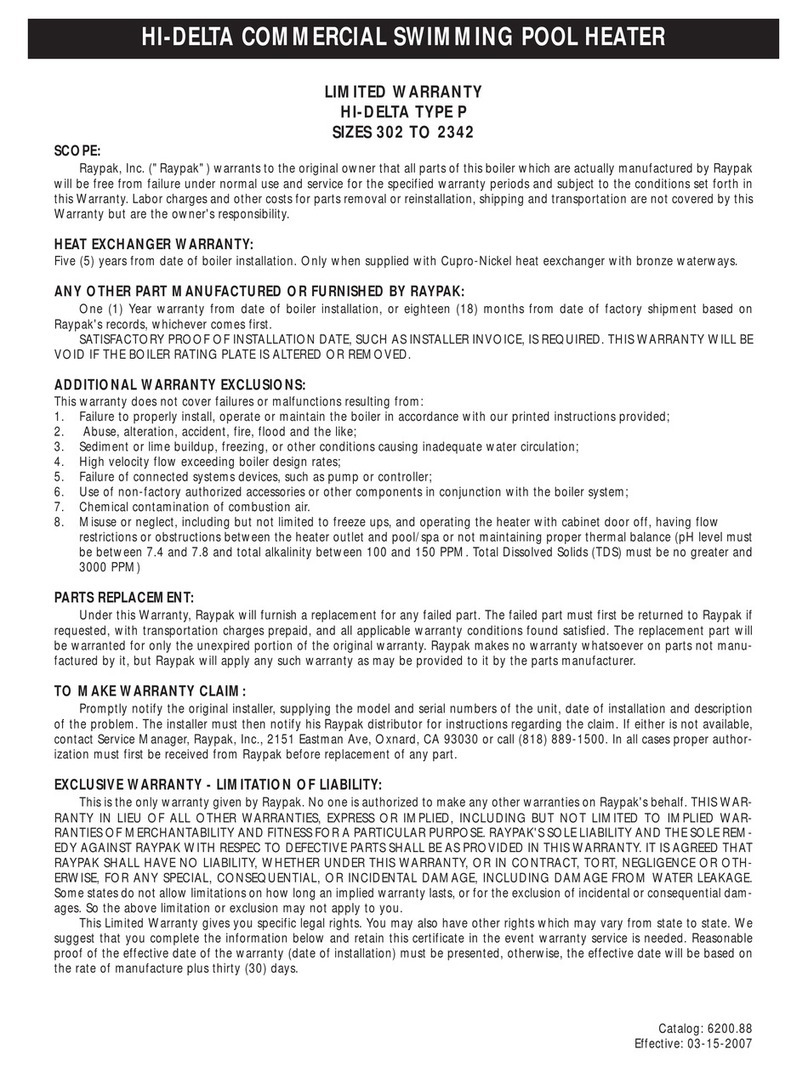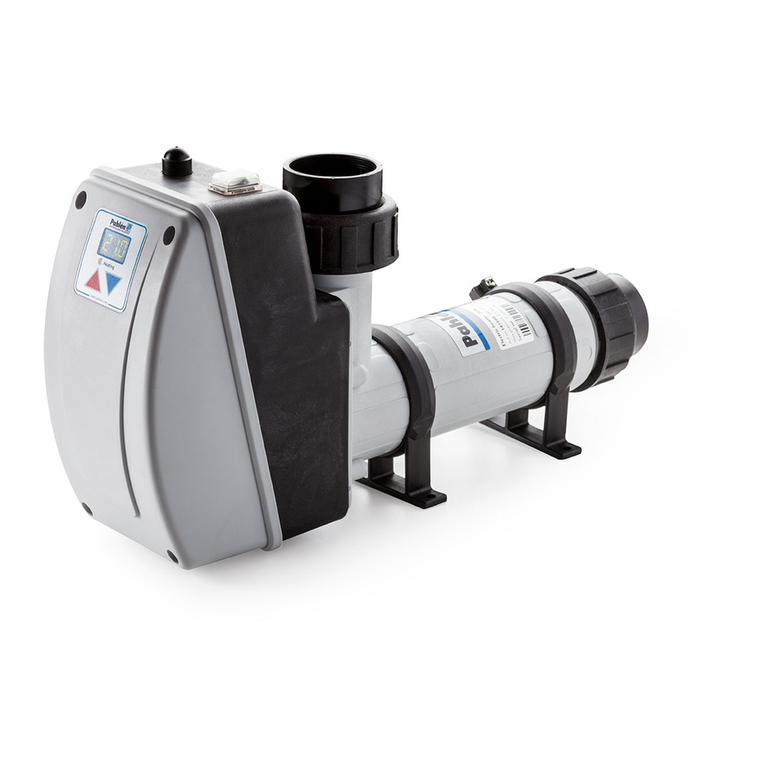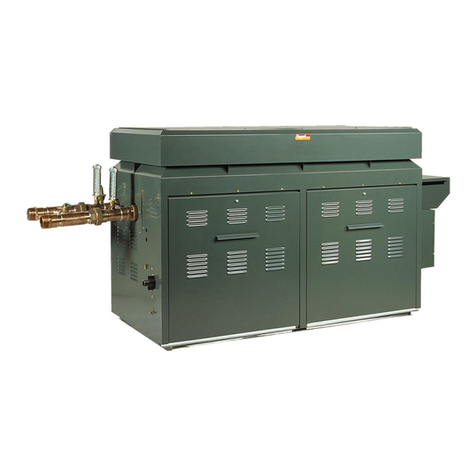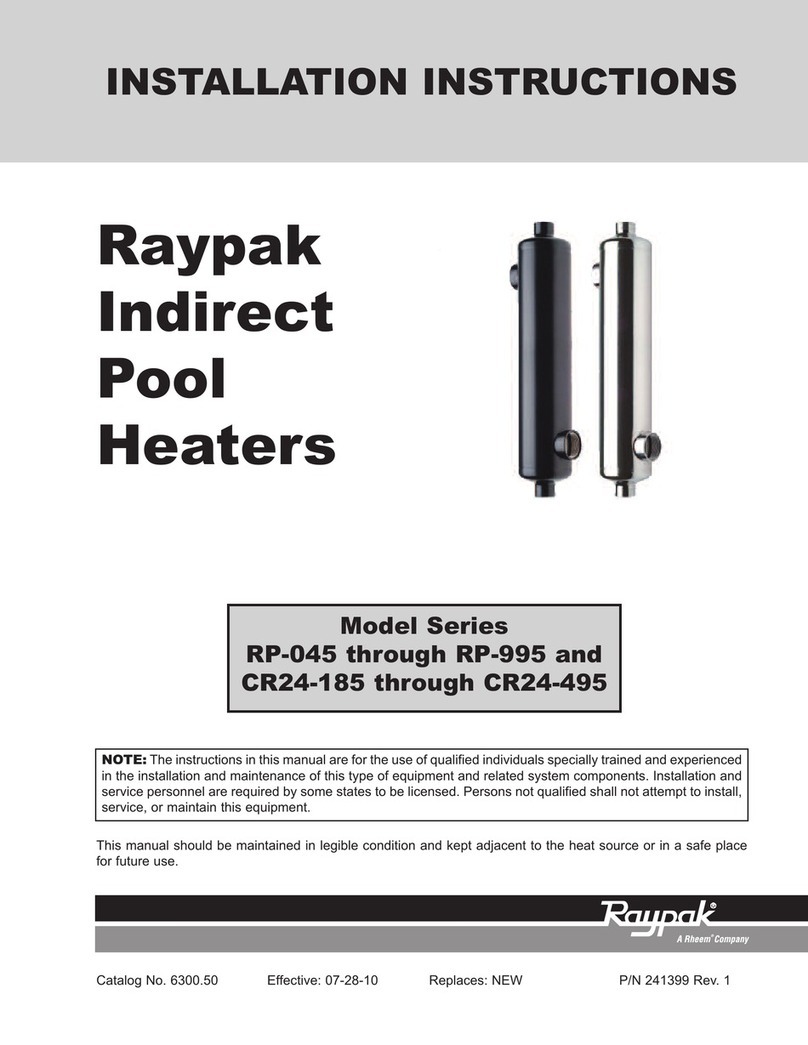Mountfield SPIRAL User guide

SPIRAL INSTRUCTION FOR INSTALLATION
AND OPERATION
SPIRAL INSTALLATION UND
BEDIENUNGSANLEITUNG
SPIRAL LIBRETTO D’ISTRUZIONI MONTAGGIO
ED USO
SPIRAL
– ИНСТРУКЦИЯ ПО МОНТАЖУ
– ИНСТРУКЦИЯ ПО МОНТАЖУ
ИЭКСПЛУАТАЦИИ
ИЭКСПЛУАТАЦИИ
SPIRAL INSTRUKCJA MONTAŻU
I EKSPLOATACJI

INSTRUCTION FOR INSTALLATION AND OPERATION
2
SPIRAL
THE SOLAR WATER HEATING SYSTEM
FOR ABOVEGROUND POOLS
RETURN NOZZLE
SAND FILTER
SWH SYSTEM
BYPASS VALVE

PLEASE, READ THIS INSTRUCTION CAREFULLY. YOUR SATISFAC-
TION WITH THIS SOLAR SYSTEM WILL DEPEND ON ITS PROPER
INSTALLATION AND USE.
NOTE, PLEASE:
a) This solar system can be installed on the roof of a nearby building. The installation will
not be as simple as it might appear. Although you might have an experience with working
on a roof and a good ladder, safety outfit and tools are available, it is strongly recommen-
ded to entrust experienced personnel of a specialist firm with the installation.
b) Install the system in a safe way, in order the solar system not to make access to the
pool easier for children and animals. Without supervision they could get drowned!
QUESTIONS AND ANSWERS
HOW DOES THE SOLAR SYSTEM
WORK?
The solar system absorbs thermal
energy of sun rays and transfers it to water
flowing through the heating system.
Cold water is sucked up from the pool
by means of a filtering system pump driven
into the solar heating system. While passing
through the system the water is heated
and returned back into the pool at a higher
temperature. The double wall design of
the heating system protects the water
from cooling by the flow of ambient air and
improves accumulation of heat. The design
has a positive effect on product efficiency.
This way the system employs the solar
energy for heating the pool for free.
Employed materials will neither corrode
nor encrust.
WHEN THE SOLAR HEATING SYSTEM
WORKS WELL?
Compared to the pools without any
heating system, the properly installed solar
system will increase water temperature in
the pool by as much as 6°C in the course of
the summer season. In the case of cloudy
or rainy weather the solar heating system
will work worse. But only within one or two
sunny days the temperature of water will
return back quickly.
Water temperature in the pool would
not exceed the level of 30 °C. Warm water
does not provide any pleasant refreshing
effect and, moreover, it will create optimum
conditions for the growth of algae. It should
be noted that temperature limitations for
certain components of pool structure may
exist. For instance, the foil of certain (foil)
pools might get soft. That is why it is not
recommended to employ the solar heating
system after the temperature of water in
the pool has reached 30 °C.
WHERE THE HEATING SYSTEM IS TO
BE INSTALLED?
Install the system in a place, exposed
to sunlight in abundance (at least 6 hours
of direct sunlight a day). The longer the
sun shines onto the solar collectors the
better will be the result of water heating. In
case the collectors are installed on a roof,
they should face southwards or south-
westwards. The optimum inclination of
the panel will be between 30 ° – 45 ° for
the operating period lasting from May to
September.
Because of safety reasons do not place
the heating system within the distance of
1.5m from the pool, where it could make it
easier for children to enter the pool.
Place the SWH system in an area, where
it s transparent cover cannot suffer any
mechanical damage from, e.g., stones flying
off a grass mower.
INSTRUCTION FOR INSTALLATION AND OPERATION
3

DO I NEED A SPECIAL PUMP?
As long as the pump of the filtering
system is in working order, there will be no
problem to install the solar water heating
system near the filter unit and the pool.
The heating system puts only minimum
restriction on the free water flow rate and
the pump will not be overloaded.
However, in the case the heating unit
is installed in a distance from the pool or
at a higher level above that of water in the
pool, a specialist should be consulted in
respect
of system installation.
The operational maximum pressure
of the solar water heating system is 2 bars.
WHAT SIZE OF THE SWH SYSTEM
SHOULD I INSTALL?
In order to maintain the efficiency
of water heating it is recommended to install
3 SWH units for the pools of the volume
up to 20 m3and 4 mutually interconnected
SWH units for the pools of the volume of
water up to 30 m3. Individual solar heating
units can be interconnected using pool
hoses; the systems should be interconnected
in parallel.
In case a lower number of heating units
has been installed, than it really corresponds
to the size of your pool, the result of such
installation will not be satisfactory.
In the areas characterised by colder and
shorter summer periods the installation
of more SWH units is recommendable.
WHICH COMPLEMENTARY PARTS ARE
REQUIRED FOR INSTALLATION?
The sufficient length of a hose or tubing
shall be required for system installation. In
respect of any other method of installation
than by the use of enclosed feet a specialist
shall be consulted. A solid installation
made of PVC pipes is recommended for
the purpose. Connecting fittings and PVC
adhesive shall be required for the purpose.
The parts made of PVC-U should be used
only with caution, as the temperatures of
materials close to the heating unit can rise
up to about 80°C.
WHAT ABOUT THE SOLAR CANVAS?
The canvas will retain heat in the pool
during the night, which is particularly
advantageous at the beginning and before
the end of the bathing season. The solar
canvas should be removed from the pool for
hot summer days, because direct sunlight
will heat water in the pool to a larger depth
than through the solar canvas. The solar
canvas can be used in combination with solar
heating. The canvas will retain heat during
nights and the SWH system will heat water
during day hours.
CONNECTING THE HEATING SYSTEM
Connect the solar heating system to the
outlet tube of the filter unit. No component
featuring hydrodynamic resistance, incl. any
valve, filter vessel, etc., that would cause
any pressure increase in the SWH heater
shall be installed between that element
and the return nozzle found in the pool.
The recommended connection of the SWH
system is shown on the title page of this
Instruction.
WHAT IS THE REASON FOR INSTALLING
THE MANUAL BYPASS LINE?
The solar heating system works
satisfactorily only if exposed to direct
sunlight. In the night the temperature of
ambient air will drop down causing the
system to operate as a cooler of the water
content of the pool.
The manual by-pass line makes it
possible to put the system out of operation
for the time, in which conditions for the
solar heating system are unsuitable (for
instance at the time of filtering in the night).
INSTRUCTION FOR INSTALLATION AND OPERATION
4

INSTALLATION
Required Tools:
zFlat blade and Phillips screwdrivers
zWrench no. 13
zHose of 32mm dia and suitable length
(for connecting the heating system with
the filter circuit)
zHose clips for securing hose connections
A) In case you have already decided to
place the SWH system freely using the
enclosed feet, install the feet according
to Figs.1 A, B – placing the washers from
above, below the nut (fig. 1).
B). Choose a suitable area near the pool (as
described herein before). The principle
of solar system installation using hoses
is evident from the picture shown on the
first page,
1) Place the SWH system in a suitable area.
2) Connect the manual by-pass line
(if provided) the two necks of the SWH;
3) Turn the filter unit OFF and disconnect its
supply cable from the socket.
4) Blind, or otherwise appropriately secure,
the inlet and outlet lines, to prevent
water to leak from the filter unit and/or
from the pool after the hoses have been
disconnected. Disconnect the filter unit
outlet hose from the return nozzle.
5) Connect the outlet hose of the filter unit
to the hose adapter found on that end
of the manual by-pass line, from which
the hose is led up to the inlet neck of the
SWH (Fig. 2).
6) Using an additional new hose interconnect
the remaining hose adapter
of manual by-pass with the return nozzle
o the pool.
7) Check all the connections and tighten the
hose clips.
8) Remove the blinds put on according to
point 4 to make the filter unit passable
for water flow.
FIG. 1 A FIG. 1 B FIG. 2
INSTRUCTION FOR INSTALLATION AND OPERATION
5
INLETNECK
OUTLETNECK
If any other method of installation employing one‘s own holders, is planned, the use of
the four fixed assembly point (see the dimensional sketch of the SWH) is recommended.
Metal holders supplied by the SWH manufacturer can be used for SWH installation. Consult
your supplier, please, in this respect.

Remarks:
Install the manual by-pass as close to
the filter unit as possible. This will shorten
the filter circuit and provide the maximum
performance of the unit in the periods, in
which either filtering or sucking operation is
carried out only.
In case the SWH system is installed in the
horizontal or even vertical position, it will not
perform satisfactorily, because of the lower
surface area exposed to direct sunlight.
In case the SWH system is installed on
a stand or a roof, etc., the connecting hoses
of shall be securely fixed to the filter unit
and the pool in order not to load inlet/outlet
necks and the SWH system as a whole with
the weight of water column contained in
the hoses. Such excessive load might cause
damage to the system and hose breakage.
Start of Operation
Check, please, whether the solar system
has been correctly connected to the filter unit
and the pool.
1) Check all connections for tightness and
leakproofness. Bleed the filter unit in
accordance with the relevant instructions
for use.
2) In case you use the manual by-pass check,
please, whether the by-pass valve is set for
directing water flow to pass through the
solar heating system.
3) Turn the pump on and check the installation
for water leaks.
4) Immediately after the pump has been
turned on, air bubbles will go out from
the return nozzle. It is quite common and
indicates that the system is being filled with
water. As soon as the air has been forced
out from the heating unit and the return
pipe, the development of bubbles will stop.
Operation
1) Leave the filtering unit and SWH system in
operation as long as the sun shines at the
system. The longer this time will be, the
quicker the poll water will reach its required
temperature heated.
2) In case the filter unit and the solar system
are left in operation in cold weather, water
in the pool will cool down. If it is the case,
open the manual by-pass valve to put the
SWH out of operation.
3) It is also recommend to put the system out
of operation for the night, by opening the
manual by-pass valve, and to cover the pool
with the solar canvass with the view of heat
loss reduction
4) Do not employ the SWH system, if the
water in the pool has exceeded the tempe-
rature of 30 °C. Such warm water will
have very dubious refreshing effects and
create favourable conditions for the growth
of algae. Moreover, certain components
of the pool might feature temperature
restrictions. For instance, the foil of foil
pools may get soft at higher temperatures.
In case your own stand is used for installation:
zThe stand shall face the sun as long as possible at its optimum angle of inclination
of 30 -°45°.
zDO NOT PLACE THE STAND IN ANY POSITION CLOSE TO THE POOL, WHERE THERE IS
A DANGER THAT CHILDREN OR ANIMALS WILL CLIMB IT AND JUMP OR FALL DOWN IN THE
POOL MORE EASILY.
OPERATION AND MAINTENANCE
THE SOLAR SYSTEM IS NOW READY FOR OPERATION
INSTRUCTION FOR INSTALLATION AND OPERATION
6

CAUTION - BE WARY OF SCALDING!
HOT WATER MAY BE RETAINED IN THE SWH SYSTEM.
HOT WATER WILL FLOW INTO THE POOL THROUGH THE RETURN NOZZLE IMMEDIATELY
AFTER SWITCHIN THE FILTER SYSTEM ON
CAUTION!
PROTECT THE SWH SYSTEM FROM DAMAGE.
THE SYSTEM MIGHT SUFFER MECHANICAL DAMAGE AS A RESULT OF SURROUNDING
TRAFFIC. TAKE DUE CARE OF IT!
STORAGE IN WINTER
CONTENTS OF SUPPLY
CONDITIONS OF GUARANTEE, SERVICE AND SPARE PARTS
DIMENSIONAL SKETCH
OF THE SWH UNIT
The solar water heating system, as well
as the filter unit, shall not freeze. Frost will
cause irreversible damage .to the SWH and
other parts of the system. Any damage
caused by frost shall not be covered by
manufacturer’s warranty.
Before the winter season drain water
from the SWH and all hoses and/or tubing,
connecting it with the filter unit and the pool.
Remove the hoses connected to the SWH
necks and leave water to flow out. You may
also rotate the unit in spiral movements to
empty it completely.
After all water has been removed it
is recommendable the SWH UNIT TO BE
DISASSEMBLED AND PUT IN A DRY STORE
PROTECTED FROM FROST.
In case you decide to leave the SWH
unit on its place, all water remaining in the
system shall be removed from the SWH
unit and other parts of the installation using
a vacuum cleaner for wet operation.
The supply comprises an assembled SWH body, a pair of legs with required jointing
material and the instruction for use.
The SWH systems installed in garden pools are supplied with guarantee for material and
manufacturing defects.
The detailed conditions of guarantee are set out in Seller’s Certificate of Guarantee. In case
you need consultation, to provide service or obtain a spare part, contact, please, your seller.
For maintenance and repair only the original spare parts should be used.
INSTRUCTION FOR INSTALLATION AND OPERATION
7
T
CH
4 ASSEMBLING HOLES

SPIRAL
SOLARHEIZUNG FÜR AUFSTELLBECKEN
RÜCKLAUFDÜSE
FILTEREINHEIT
SOLARHEIZUNG
BYPASSVENTIL
INSTALLATION UND BEDIENUNGSANLEITUNG
8

LESEN SIE BITTE AUFMERKSAM DIESE BEDIENUNGSANLEITUNG.
IHRE ZUFRIEDENHEIT MIT DIESER SOLARANLAGE IST VON IHRER
RICHTIGEN INSTALLATION UND IHREM EINSATZ ABHÄNGIG.
ACHTUNG: a) Diese Solaranlage kann auf dem Dach eines nahegelegenen Gebäudes mon-
tiert werden. Solche Installation ist aber nicht so einfach, wie es scheint. Auch wenn Sie Er-
fahrung in der Arbeit auf Dächern haben, über eine geeignete Leiter, Sicherheitsausrüstu-
ng und Werkzeuge verfügen, empfehlen wir Ihnen, dass Sie die Installation einer Fachfirma
mit geschulten Mitarbeiter anzuvertrauen.
b) Die Installation führen Sie so durch, dass die Solaranlage Kindern oder Tieren Zugang
zum Pool nicht erleichtert. Unbeaufsichtigt könnten sie ertrinken!
FRAGEN UND ANTWORTEN
WIE FUNKTIONIERT DIE
SOLARHEIZUNG?
Die Solarheizung absorbiert die
Wärmeenergie der Sonnenstrahlung und
übergibt sie an das Wasser, das durch den
Heizkörper fließt.
Kaltes Wasser aus dem Becken wird
mittels einer Pumpe des Filtrationssystems
in die Solarheizung angetrieben. Durchfluss
durch die Solarheizung erwärmt das Wasser,
das dann an den Pool wärmer zurückgegeben
wird. Doppelaufbau der Heizungsanlage
verhindert Abkühlen von der Umgebungsluft
und bietet auch einen Wärmestau, was
positiv die Wirksamkeit des Produkts
beeinflusst. Somit nutzen Sie kostenlos die
Solarenergie, um das Becken zu heizen. Die
verwendeten Materialien weder rosten noch
mit Wasserstein bedeckt werden.
WANN FUNKTIONIERT DIE
SOLARHEIZUNG RICHTIG?
Eine ordnungsgemäß installierte
Solaranlage erhöht die Temperatur des
Badewassers um bis zu 6°C während der
Saison im Vergleich zu den Pools ohne
Heizung. Wenn es bewölkt oder regnerisch
wird, wird die Solarheizung schlimmer
arbeiten. Nur ein oder zwei sonnige Tage aber
reichen und die Wassertemperatur wieder
schnell zurückkommt.
Die Wassertemperatur sollte 30°C
nicht überschreiten. Warmes Wasser
ist nicht sehr erfrischend und schafft
optimale Bedingungen für das Wachstum
von Algen. Außerdem können einige
Beckenkomponenten thermische
Einschränkungen haben. Zum Beispiel
kann es zum Erweichen der Folie bei
Folienbecken führen. Daher verwenden Sie
die Solarheizung nicht, wenn das Wasser im
Becken 30°C erreicht.
WOHIN SOLL ICH DIE SOLARHEIZUNG
STELLEN?
Stellen Sie die Solarheizung dort, wo es
viel direkter Sonneneinstrahlung (mindestens
6 Stunden pro Tag) gibt. Je länger die Sonne
die Heizung bescheint, desto besser das
Ergebnis der Wassererwärmung wird. Wenn
Sie die Installation auf das Dach gewählt
haben, orientieren Sie die Heizungsanlage
gegen Süden bis Südwesten. Die optimale
Neigung der Heizungsanlage für den
Betriebszeitraum von Mai bis September ist
zwischen 30 bis 45 Grad.
Aus Sicherheitsgründen sollten Sie nicht
die Heizung in einem Abstand von 1,5m vom
Becken installieren. Es könnte den Eintritt von
Kindern oder Tieren ins Becken erleichtern.
Den Standort der Solarheizung wählen
Sie so, dass zu einer mechanischen
Beschädigung der transparenten Abdeckung
nicht kommen kann, wie z.B. vom fliegenden
Steinen beim Rasenmähen.
INSTALLATION UND BEDIENUNGSANLEITUNG
9

BRAUCHE ICH EINE SPEZIELLE PUMPE?
Wenn die Fitrationspumpe in Ordnung ist,
wird es kein Problem mit der Installation von
der Solaranlage in der Nähe der Filtereinheit
und des Beckens. Die Heizung beschränkt den
freien Durchfluss nur minimal, so dass es zur
Belastung der Pumpe nicht kommt.
Nur wenn die Heizung weiter von
dem Becken oder über dem Wasserstand
im Becken installiert wird, muss diese
Installation mit einem Experten konsultiert
werden.
Der maximale Betriebsdruck von der
Solarheizung ist 2 bar.
WIE VIELE SOLARANLAGEN SOLLTE ICH
VERWENDEN?
Um die Wirksamkeit der Wasserer-
wärmung zu halten, ist es empfohlen, fürs
Becken mit einem Volumen von bis zu 20 m3
drei Solaranlagen zu verwenden und fürs
Becken mit einem Volumen von bis zu 30 m3
dann vier miteinander verbundene So-
larheizungsanlagen zu verwenden. Einzelne
Heizungsanlagen können miteinander mit
Poolschläuchen verbunden werden, die Ver-
bindung wird paraparallel durchgeführt.
Wenn Sie weniger Heizungsanlagen
verwenden, als wie viel der Größe Ihres
Beckens entspricht, wird das Ergebnis der
Solarheizung nicht zufriedenstellend. In
Regionen, wo kühler und kürzer Sommer ist,
empfehlen wir, lieber mehr Heizungsanlagen
zu verwenden.
WELCHE ANDEREN TEILE SIND FÜR DIE
INSTALLATION ERFORDERLICH?
Zu der Installation werden Sie eine
ausreichende Länge der Schlauch oder Rohr
brauchen. Eine andere Installation als auf
die beigefügten Füssen muss mit einem
Fachmann konsultiert werden, für diesen
Einsatz empfehlen wir eine feste Errichtung
von PVC-Rohren zu verwenden; dazu werden
Sie einen PVC-Kleber und entsprechende
Fittings brauchen.
Vorsicht bei der Verwendung von PVC-U
in der unmittelbaren Nähe der Heizung, wo
die Temperatur bis zu 80°C erreichen kann.
UND WAS DIE SOLARABDECKPLANE?
Die Solarabdeckplane hält die Wärme im
Becken in der Nacht, vor allem am Anfang
und am Ende der Badesaison. An heißen
Sommertagen muss die Solarabdeckplane
aus dem Pool entfernt werden, weil die
direkte Sonnenstrahlung das Wasser tiefer
als durch das Material der Solarabdeckplane
erwärmt. Die Solarabdeckplane kann
in Kombination mit Solaranlagen
verwendet werden - in der Nacht hält die
Solarabdeckplane die Wärme, tagsüber
wärmt das Wasser die Solarheizung.
WIE SOLL DIE SOLARHEIZUNG
ANGESCHLOSSEN WERDEN?
Die Solarheizung schließen Sie an
den Filtrationsausgang. Zwischen der
Heizungsanlage und der Rücklaufdüse ins
Becken darf kein Widerstand sein, wie z.B.
ein Ventil, ein Filterbehälter usw., der den
Druck in dem Heizkörper erhöhen könnte. Der
empfohlene Anschluss der Heizungsanlage
ist auf der Titelseite dieser Anleitung
angezeigt.
WOZU DIENT DER MANUELLE BYPASS
DER SOLARHEIZUNG?
Die Solarheizung funktioniert nur dann,
wenn sie von der Sonne beleuchtet ist. In der
Nacht ist die Temperatur der Umgebungsluft
niedriger und das würde zum gegenteiligen
Effekt, d.h. zu der Wasserkühlung, führen.
Der manuelle Bypass ermöglicht die Anlage
außer Betrieb dann zu setzen, wann die
Bedingungen für die Solarheizung nicht
geeignet sind, z.B. bei der Nachtfilterung.
INSTALLATION UND BEDIENUNGSANLEITUNG
10

INSTALLATIONSVERFAHREN
Benötigte Werkzeuge:
zFlach- und Kreuzschlitz-Schraubendreher
zSchlüssel Nr. 13
zSchlauch mit Durchmesser 32mm einer
geeigneten Länge (für Anschließen der
Heizungsanlage mit dem Filtrationskre-
islauf)
zSchlauchschellen zur Sicherung der
Schlauchverbindungen
Falls Sie sich für freie Platzierung der
Heizungsanlage auf den beigefügten Füssen
entschieden haben, führen Sie ihre Montage
durch (Abb. 1 A, B) - Installieren Sie die fla-
chen Unterlegscheiben auf die Oberseite des
Panels, unter die Mutter (ABB. 1 B). Wählen
Sie einen geeigneten Platz in der Nähe des
Beckens (siehe oben). Für das Prinzip der
Installation von der Solarheizung durch
Schläuche siehe das Bild auf der Titelseite.
1) Stellen Sie die Heizungsanlage auf den
gewählten Platz.
2) Verbinden Sie den manuellen Bypass
(falls Sie einen haben) mit beiden Ans-
chlüssen der Heizungsanlage.
3) Schalten Sie die Filtereinheit aus und zie-
hen Sie ihr Netzkabel aus der Steckdose.
4) Verstopfen Sie oder anderweitig geeignet
sichern Sie die Ein- und Ausgangsleitun-
gen, damit nach Lösung der Schlauche
das Wasser aus der Filtereinheit oder
aus dem Becken nicht ausfließen konnte.
Entfernen Sie den Ausgangsschlauch aus
der Filtereinheit von der Rücklaufdüse.
5) Schließen Sie den Ausgangsschlauch aus
der Filtereinheit an die Schlauchtülle an
der Seite des manuellen Bypass an, aus
welcher der Schlauch in den Eingang der
Solarheizung leitet (ABB 2).
6) Schließen Sie die andere Schlauchtülle
der manuellen Bypass durch einen
neuen Schlauch an die Rücklaufdüse des
Beckens an.
7) Überprüfen Sie die Verbindung von
Schläuchen und ziehen Sie die Schlauch-
schellen an.
8) Entfernen Sie die in Punkt 4 aufgesetzten
Stopfen so, dass die Filtereinheit durch-
gängig ist.
ABBILDUNG 1 A ABBILDUNG 1 B ABBILDUNG 2
INSTALLATION UND BEDIENUNGSANLEITUNG
11
EINGANGSANSCHLUSS
AUSGANGSANSCHLUSS
Für einen anderen Weg der Installation auf eigene Hälter wird empfohlen, 4 stabile Befesti-
gungspunkte (siehe Maßzeichnung der Heizungsanlage) zu verwenden. Zur Befestigung der
Heizungsanlage ist es möglich, die von dem Hersteller der Heizungsanlage gelieferten Metallhal-
ter zu verwenden. Erkundigen Sie sich bei Ihrem Fachhändler.

Bemerkungen:
Installieren Sie den manuellen Bypass am
nächsten zu der Filtereinheit. So verkürzen
Sie den Filterkreislauf und verwenden Sie die
maximale Leistung der Filtration, wenn Sie nur
filtern oder saugen.
Im Falle des horizontalen oder sogar ver-
tikalen Aufbaus ist die Erwärmung nicht völlig
wirksam, weil ihre der Sonne ausgesetzte
Oberfläche kleiner ist.
Wenn die Heizungsanlage auf einem Ges-
tell, Dach usw. installiert ist, ist es notwendig,
die Verbindungsschläuche zu der Filtereinheit
und zu dem Becken so zu sichern, dass die
Schlauchtüllen so wie die Heizungsanlage
nicht mit dem Gewicht der in den Schläuchen
vorkommenden Wassersäule belastet wird.
Überbelastung kann zu einer Beschädigung
der Heizungsanlage oder zu einem Bruch der
Schläuche führen.
Inbetriebnahme
Überprüfen Sie, dass Sie die Solaranlage
an die Filtereinheit und das Becken richtig
angeschlossen haben.
1) Überprüfen Sie die Dichtheit und Nachzie-
hung der Anschlusse. Entlüften Sie die Fil-
tereinheit nach der Gebrauchsanweisung.
2) Falls Sie einen manuellen Bypass verwen-
den, überprüfen Sie, ob das Bypass-Ventil
so eingestellt ist, dass das Wasser durch
die Heizungsanlage durchfließen kann.
3) Schalten Sie die Pumpe ein und überprü-
fen Sie die Installation, ob das Wasser
irgendwo nicht fließt.
4) Unmittelbar nach dem Einschalten der
Pumpe beginnen Luftblasen aus der
Rücklaufdüse auszugehen. Das ist üblich
und bedeutet, dass die Heizungsanlage
mit Wasser gefüllt wird. Sobald die Luft
aus der Heizungsanlage und aus der
Rücklaufleitung verdrängt wird, Blasen
aufhören rauszukommen.
Betrieb
1) Lassen Sie die Filtereinheit mit der Sola-
ranlage im Betrieb zu allen Zeiten, wenn
die Sonne an die Heizungsanlage scheint.
Je länger diese Zeit ist, desto mehr und
schneller das Becken erwärmt.
2) Wenn Sie die Filtereinheit und die Solaran-
lage in der Kälte in Betrieb lassen, wird das
Wasser im Becken umgekehrt erkalten.
In diesem Fall, öffnen Sie rechtzeitig das
manuelle Bypass-Ventil und setzen Sie
damit die Solarheizung außer Betrieb.
3) In der Nacht empfehlen wir Ihnen, die So-
larheizung durch Öffnung des manuellen
Bypass-Ventils außer Betrieb zu setzen
und das Becken mit einer Solarabdeckpla-
ne zu bedecken, um die Wärmeverluste zu
reduzieren.
4) Verwenden Sie die Solarheizung nicht,
wenn die Wassertemperatur 30°C über-
steigt. Damit wird das Wasser zu warm
um erfrischen zu können und bietet ideale
Bedingungen für das Wachstum von Algen.
Einige Beckenkomponenten können auch
thermische Einschränkungen haben. Zum
Beispiel kann es zum Erweichen der Folie
bei Folienbecken führen.
Wenn Sie ein eigenes Gestell verwenden:
zDas Gestell muss so ausgerichtet sein, dass die Sonne darauf so viel wie möglich scheint
und in der Neigung von 30-45°.
zINSTALLIEREN SIE DAS GESTELL NICHT SO NAH AN DAS BECKEN; WO DIE GEFAHR IST,
DASS KINDER ODER TIERE ES KLETTERN UND DAMIT MEHR EINFACH INS BECKEN KOMMEN
KÖNNEN.
BETRIEB UND WARTUNG
JETZT IST DIE SOLARANLAGE BETRIEBSFÄHIG
INSTALLATION UND BEDIENUNGSANLEITUNG
12

WARNUNG - VERBRÜHUNGSGEFAHR: IN DER SOLARANLAGE KANN HEISSES WASSER
SEIN. SOFORT NACH DER EINSCHALTUNG DER FILTEREINHEIT WIRD HEISSES WASSER
DURCH DIE RÜCKLAUFDÜSE INS BECKEN STRÖMEN.
WARNUNG - GEFAHR DER HEIZUNGSANLAGEBESCHÄDIGUNG: DIE SOLARHEIZUNG KANN
IM FOLGE DES UMLIEGENDEN BETRIEBS MECHANISCH BESCHÄDIGT WERDEN.
SEIEN SIE VORSICHTIG MIT DER HEIZUNGSANLAGE.
WINTERBEWAHRUNG
LIEFERUMFANG
GARANTIEBEDINGUNGEN, SERVICE UND ERSATZTEILE
Einfrieren der Solarheizung, sowie Ihrer
Filtereinheit ist zu vermeiden. Der Frost hat
irreversible Schäden an der Heizungsanlage
und an ihren anderen Elementen zur Folge.
Die Garantie bezieht sich nicht auf die Frost-
schäden.
Früher als es beginnt zu frieren, lassen
Sie das Wasser aus der Heizungsanlage oder
aus der Rohrverbindungen mit der Filtere-
inheit und mit dem Becken ab. Entfernen
Sie die an die Ausgänge der Solarheizung
angeschlossenen Schläuche und lassen Sie
das Wasser herausfließen, eventuell gießen
Sie es aus der Heizungsanlage durch eine
Schrauben-Drehung.
Nach vollständiger Entwässerung
EMPFEHLEN WIR IHNEN DIE HEIZUNGSAN-
LAGE ZU DEMONTIEREN UND AN EINEM
TROCKENEN VOR FROST GESCHÜTZTEN ORT
ZU LAGERN.
Wenn Sie die Heizungsanlage an seinem
Platz bleiben lassen, ist es notwendig, mit ei-
nem Nass-Staubsauger alles Restwasser aus
der Heizungsanlage sowie auch aus anderen
Teilen der Anlage zu entfernen.
Die Verpackung beinhaltet einen zusammengestellten Körper der Heizungsanlage, ein
paar abnehmbare Füße mit Verbindungsmaterial und die Gebrauchsanweisung.
Für Solarsystem der Wasserheizung für Gartenpools wird Garantie für Material-und
Herstellungsfehler gewährleistet. Die Garantiebedingungen sind dem Garantieschein des
Verkäufers zu entnehmen. Falls Sie einen Rat, Service oder einen Ersatzteil brauchen, wenden
Sie sich an Ihren Fachhändler. Für Wartungs-und Reparaturarbeiten verwenden Sie Originaler-
satzteile.
INSTALLATION UND BEDIENUNGSANLEITUNG
13
Maßzeichnung der Heizungsanlage 4X MONTAGELOCH ø 9MM

LIBRETTO D’ISTRUZIONI MONTAGGIO ED USO
14
SPIRAL
SISTEMA DI RISCALDAMENTO SOLARE
PER PISCINE FUORI TERRA
UGELLO DI RITORNO
FILTRAZIONE
RISCALDAMENTO
SOLARE
VALVOLA DI DEVIAZIONE

LIBRETTO D’ISTRUZIONI MONTAGGIO ED USO
15
SI PREGA DI LEGGERE ATTENTAMENTE IL PRESENTE LIBRETTO. LA
VOSTRA SODDISFAZIONE CON IL SISTEMA SOLARE DIPENDERA’
DALLA SUA INSTALLAZIONE ED USO CORRETTI.
ATTENZIONE: a) Il sistema di riscaldamento solare può essere installato anche sul
tetto di una casa vicina. L’installazione non è mica semplice, come sembra. Nonostante
che abbiate esperienze con lavori sui tetti ed abbiate a disposizione scale e dispositivi
e strumenti di sicurezza adeguati, consigliamo vivamente di rivolgervi ad un’azienda
specializzata che dispone dei lavoratori istruiti.
b) Realizzare l’installazione affinché i bambini o gli animali non possano entrare nella
piscina salendo o arrampicandosi sul sistema di riscaldamento solare. I bambini non
osservati potrebbero cadere nella piscina ed annegarsi!
DOMANDE E RISPOSTE
COME FUNZIONA IL SISTEMA DI
RISCALDAMENTO SOLARE?
Il sistema di riscaldamento solare
riceve l’energia termica dai raggi solari e la
rilascia all’acqua che scorre nel sistema di
riscaldamento solare.
L’acqua fredda proveniente dalla
piscina viene convogliata nel sistema di
riscaldamento solare tramite la pompa
filtrante. L’acqua, scorrendo nel sistema di
riscaldamento solare, si riscalda, dopodiché
ritorna nella piscina. La struttura sdoppiata
del sistema di riscaldamento solare ostacola il
raffreddamento dell’acqua dall’aria circostante,
inoltre, garantisce l’accumulo del calore
per influire positivamente sull’efficacia del
prodotto. Quindi, il sistema di riscaldamento
solare vi permette di utilizzare gratuitamente
l’energia solare per il riscaldamento dell’acqua
nella piscina.
Il materiale utilizzato per produrre
il sistema di riscaldamento solare non
arrugginisce e non si copre di incrostazioni
calcaree.
QUANDO FUNZIONA BENE IL SISTEMA DI
RISCALDAMENTO SOLARE?
Durante la stagione estiva il sistema di
riscaldamento solare installato correttamente
aumenta la temperatura dell’acqua nella piscina
anche di 6 °C rispetto all’acqua nella piscina
non riscaldata. Qualora il cielo sia nuvoloso
oppure piova, il sistema di riscaldamento
solare funziona peggio, in ogni modo, basta uno
o due giorni di sole e la temperatura dell’acqua
ritorna a quella precedente.
La temperatura dell’acqua nella piscina
non dovrebbe superare i 30 °C. L’acqua troppo
calda non rinfresca, in più, crea condizioni
favorevoli per la proliferazione di alghe, inoltre,
alcuni componenti delle piscine in telo di plastica
possono avere un intervallo di temperatura
operativa limitato, di conseguenza, il materiale
plastico delle piscine potrebbe ammorbidirsi.
Non usare, dunque, il sistema di riscaldamento
solare quando la temperatura dell’acqua nella
piscina raggiunge i 30 °C.
DOVE BISOGNA COLLOCARE IL SISTEMA
DI RISCALDAMENTO SOLARE?
Il sistema di riscaldamento solare
deve essere collocato su un posto
sufficientemente illuminato dai raggi
solari diretti (almeno per sei ore al giorno).
Più tempo il sole splenderà sul sistema
di riscaldamento solare, migliore sarà il
risultato del riscaldamento dell’acqua nella
piscina. Qualora scegliate la collocazione sul
tetto, direzionare il sistema di riscaldamento
solare verso il sud o sudovest. L’inclinazione
migliore del sistema di riscaldamento solare
utilizzato da maggio a settembre rientra
nell’intervallo di 30–45°.
Per motivi di sicurezza non collocare
il sistema di riscaldamento solare ad una
distanza di 1,5m dalla piscina siccome

LIBRETTO D’ISTRUZIONI MONTAGGIO ED USO
16
potrebbe facilitare l’entrata dei bambini
o degli animali nella piscina stessa.
Scegliere la collocazione del sistema di
riscaldamento solare affinché venga evitato
il danneggiamento meccanico dell’involucro
trasparente, ad es. con pietre proiettante da un
tagliaerba.
HO BISOGNO DI UNA POMPA SPECIALE?
Qualora la pompa filtrante funzioni bene,
non esiste alcun problema con l’installazione
del sistema di riscaldamento solare vicino al
sistema di filtrazione della piscina. Il sistema
di riscaldamento solare limita la portata
dell’acqua solo minimamente, quindi, la pompa
non viene sollecitata affatto.
Solo qualora il sistema di riscaldamento
solare venga installato lontano dalla piscina
o sopra il livello dell’acqua nella piscina, occorre
rivolgersi ad un professionista.
La pressione operativa massima del
sistema di riscaldamento solare è di 2 bar.
QUANTO GRANDE DEVE ESSERE IL
SISTEMA DI RISCALDAMENTO SOLARE?
Per garantire l’efficienza del riscaldamento
dell’acqua nella piscina si consiglia di usare 3
sistemi di riscaldamento solare per le piscine
con il volume dell’acqua fino a 20 m3e 4
sistemi di riscaldamento solare per le piscine
con il volume dell’acqua fino a 30 m3. I singoli
sistemi di riscaldamento solare possono essere
collegati, l’uno con l’altro, tramite tubi flessibili
e nel modo parallelo.
Qualora scegliate il numero inferiore dei
sistemi di riscaldamento solare rispetto a quello
occorrente per la dimensione della piscina, il
risultato del sistema di riscaldamento solare
non sarà soddisfacente. Si consiglia di utilizzare
un numero dei sistemi di riscaldamento
solare superiore nelle zone più fredde o meno
soleggiate.
QUALI ALTRI COMPONENTI OCCORRONO
PER L’INSTALLAZIONE?
Per l’installazione del sistema di
riscaldamento solare bisogna dotarsi di tubi
flessibili o rigidi di lunghezza sufficiente.
L’installazione diversa e senza l’utilizzo dei
piedini in dotazione deve essere fatta con
l’assistenza di un professionista; in tal caso si
consiglia di procedere all’installazione fissa
con tubi in PVC. In tal caso avrete bisogno della
colla per PVC ed i rispettivi raccordi.
Attenzione all’uso del PVC-U nella stretta
vicinanza al sistema di riscaldamento solare
nel quale la temperatura dell’acqua potrebbe
raggiungere anche gli 80 °C.
ED IL TELO SOLARE?
Il telo solare conserva durante la notte il
calore accumulato nella piscina, in particolare
all’inizio ed alla fine della stagione balneare.
Durante le giornate estive il telo solare deve
essere rimosso dalla piscina siccome i raggi
solari diretti riscaldano l’acqua nella profondità
maggiore rispetto a quando la piscia sia
coperta dal telo solare. Il telo solare può
essere adoperato benissimo combinandolo
con il sistema di riscaldamento solare. Durante
la notte il telo conserverà il calore e durante
la giornata il sistema di riscaldamento solare
riscalderà l’acqua.
COME COLLEGARE IL SISTEMA DI
RISCALDAMENTO SOLARE?
Il sistema di riscaldamento solare deve
essere collegato con l’uscita dal sistema
filtrante. Tra il sistema di riscaldamento
solare e l’ugello di ritorno non deve essere
presente alcun elemento resistente, ad
es. valvola, vaschetta filtrante ecc. che
aumenti la pressione nel corpo del sistema
di riscaldamento solare. Il collegamento
consigliato del sistema di riscaldamento solare
è raffigurato sul frontespizio del Libretto
d’istruzioni.
A CHE COSA SERVE LA DERIVAZIONE
MANUALE DEL SISTEMA DI
RISCALDAMENTO SOLARE?
Il sistema di riscaldamento solare funziona
bene solo nel caso in cui è illuminato dai raggi
solari. Durante la notte la temperatura dell’aria
circostante risulta inferiore all’acqua nella
piscina il che potrebbe provocare un effetto
inverso, cioè il raffreddamento dell’acqua. La
derivazione manuale permette di scollegare
il sistema di riscaldamento solare durante il
periodo di tempo in cui non esistono condizioni
favorevoli per il riscaldamento solare, ed es.
durante la filtrazione notturna.

LIBRETTO D’ISTRUZIONI MONTAGGIO ED USO
17
PROCEDIMENTO ELEMENTARE
PER L’INSTALLAZIONE
Utensili occorrenti:
zgiravite fisso o a stella
zchiave inglese No. 13
ztubo flessibile di diametro di 32mm e
di lunghezza adeguata (per collegare il
sistema di riscaldamento solare con il
sistema filtrante)
zgiunti per garantire collegamenti tubolari
Qualora abbiate optato per il posizionamento
libero del sistema di riscaldamento solare
e sui piedini in dotazione, procedere al loro
montaggio (FIG. 1 A, B). Le rondelle piatte
vanno installate sul lato superiore del pa-
nnello, sotto il dado (FIG. 1 B). Scegliere una
superficie adeguata e vicina alla piscina (si
veda il testo sopra). L’installazione del siste-
ma di riscaldamento solare con tubi flessibili
è raffigurato sul frontespizio.
1) Posizionare il sistema di riscaldamento
solare sul posto definito.
2) Collegare la derivazione manuale (se ce
l’avete) con entrambe le uscite del siste-
ma di riscaldamento solare.
3) Spegnere il sistema di filtrazione e sta-
ccare il cavo di alimentazione dalla presa.
4) Tappare o assicurare in un altro modo
adeguato i tubi d’uscita e d’entrata
affinché una volta scollegati l’acqua
non poteva fuoriuscire dal sistema di
filtrazione o dalla piscina. Scollegare il
tubo flessibile, che esce dal sistema di
filtrazione, e l’ugello di ritorno.
5) Collegare il tubo flessibile che esce dal
sistema di filtrazione con lo spinotto
posizionato su un lato della derivazione
manuale dalla quale esce un altro tubo
flessibile verso il sistema di riscaldamen-
to solare (FIG. 2).
6) Collegare un altro tubo, nuovo, con lo spi-
notto restante della derivazione manuale
e con l’ugello di ritorno.
7) Controllare i collegamenti tubolari
e stringere i rispettivi giunti.
8) Togliere i tappi applicati al punto 4 affin-
ché la filtrazione possa essere azionata.
FIGURA 1 A FIGURA 1 B FIGURA 2
USCITA DI MANDATA
USCITA DI MANDATA
Per un altro modo dell’installazione ad. es. sui supporti personalizzati si consiglia comunque
di sfruttare 4 punti di montaggio rigidi (si veda il Disegno del sistema di riscaldamento solare
con quote). Per fissare il sistema di riscaldamento solare utilizzare i supporti metallici forniti dal
produttore del sistema di riscaldamento solare. In tal caso contattare il rivenditore.

LIBRETTO D’ISTRUZIONI MONTAGGIO ED USO
18
Annotazioni:
Installare la derivazione manuale al
più vicino possibile al sistema di filtrazione
per accorciare il circuito di filtrazione e per
sfruttare al massimo la potenza del sistema
di filtrazione quando si effettua ad es. la sola
filtrazione o aspirazione.
Nel caso dell’installazione orizzontale
o addirittura di quella verticale il sistema di
riscaldamento solare non è perfettamente
efficiente siccome la sua superficie esposta al
sole risulta ridotta.
Qualora il sistema di riscaldamento sola-
re venga installato su un supporto, tetto ecc.,
occorre collocare i tubi flessibili collegati al
sistema di filtrazione ed alla piscina affinché
non sollecitino troppo i rispettivi spinotti ed il
sistema di riscaldamento solare stesso con la
colonna d’acqua contenuta nei tubi stessi.
La sollecitazione eccessiva potrebbe provoca-
re danni sul sistema di riscaldamento solare
o addirittura la rottura dei tubi.
Messa in funzionamento
Controllare se il sistema di riscaldamento
solare è stato collegato correttamente con il
sistema filtrante e con la piscina.
1) Controllare la tenuta ed il serraggio dei
giunti. Spurgare l’aria dal sistema filtrante
secondo il rispettivo Libretto d’istruzioni.
2) Qualora utilizziate la derivazione manuale,
controllare se la valvola di derivazione è
stata impostata affinché l’acqua possa sco-
rrere nel sistema di riscaldamento solare.
3) Accendere la pompa e controllare l’installa-
zione di tutto il sistema di riscaldamento
solare e se l’acqua non fuoriesce da qualche
parte.
4) Dopo l’accensione della pompa dall’ugello di
ritorno iniziano a fuoriuscire delle bollici-
ne d’aria. Questo fenomeno è normale e
documenta il riempimento del sistema di
riscaldamento solare con l’acqua. Appena
l’aria viene espulsa dal sistema di riscalda-
mento solare e dai tubi di ritorno, le bollicine
smettono di fuoriuscire.
Funzionamento
1) Lasciar acceso il sistema filtrante collegato
con il sistema di riscaldamento solare per
tutto il tempo in cui il sistema di riscalda-
mento solare è irradiato dal sole. Più lungo
sarà questo tempo, meglio e più veloce-
mente la piscina sarà riscaldata.
2) Qualora lasciate acceso il sistema filtrante
collegato con il sistema di riscaldamento
solare durante il periodo freddo, l’acqua
nella piscina diventerà fredda. In tal caso
aprire la valvola della derivazione manuale e
mettere fuori servizio il sistema di riscalda-
mento solare.
3) Si consiglia di mettere fuori servizio il
sistema di riscaldamento solare durante la
notte aprendo la valvola della derivazione
manuale e coprendo la piscina con il telo
solare per ridurre le perdite del calore.
4) Il sistema di riscaldamento solare non deve
essere utilizzato più quando la temperatu-
ra dell’acqua nella piscina supera i 30 °C.
L’acqua troppo calda non rinfresca, in più
crea condizioni favorevoli per la proliferazi-
one di alghe, inoltre, alcuni componenti delle
piscine in telo di plastica possono avere un
intervallo di temperatura operativa limitato,
di conseguenza, il materiale plastico delle
piscine potrebbe ammorbidirsi.
Qualora utilizziate un supporto personalizzato:
zil supporto deve esser rivolto più favorevolmente possibile verso il sole rispettando l’inter-
vallo dell’inclinazione di 30–45°.
zNON COLLOCARE IL SUPPORTO NELLA VICINANZA DELLA PISCINA DOV’E’ PRESENTE IL PE-
RICOLO CHE I BAMBINI O GLI ANIMALI POSSANO UTILIZZARLO PER SALIRE SU ED ENTRARE
FACILMENTE NELLA PISCINA.
FUNZIONAMENTO E MANUTENZIONE
ORA IL SISTEMA DI RISCALDAMENTO SOLARE E’ PRONTO
AL FUNZIONAMENTO.

LIBRETTO D’ISTRUZIONI MONTAGGIO ED USO
19
ATTENZIONE ALL’USTIONE!
L’ACQUA CHE SCORRE NEL SISTEMA DI RISCALDAMENTO SOLARE PUO’ ESSERE MOLTO
CALDA. SUBITO DOPO L’ACCENSIONE DEL SISTEMA DI FILTRAZIONE L’UGELLO DI RITORNO
EMETTE L’ACQUA MOLTO CALDA.
ATTENZIONE AL DANNEGGIAMENTO DEL SISTEMA DI RISCALDAMENTO SOLARE!
IL SISTEMA DI RISCALDAMENTO SOLARE PUO’ ESSERE DANNEGGIATO MECCANICA-
MENTE DAI LAVORI SVOLTI NELLA ZONA CIRCOSTANTE.
PRESTARE ATTENZIONE AL SISTEMA DI RISCALDAMENTO SOLARE.
MESSA A RIPOSO PRIMA DELL’INVERNO
Il sistema di riscaldamento solare ed il
sistema di filtrazione non possono gelare.
Il gelo provoca danni irreversibili sia sul
sistema di riscaldamento solare sia su altri
elementi. La garanzia prestata non copre
i danni causati dal gelo.
Prima dell’arrivo della stagione fredda
eliminare l’acqua dal sistema di riscalda-
mento solare e dai tubi flessibili o rigidi che
collegano il sistema filtrante con la piscina.
Smontare i tubi flessibili collegati con le
uscite dei sistemi di riscaldamento solare
e lasciar fuoriuscire tutta l’acqua, eventu-
almente eliminarla dal sistema di riscalda-
mento solare movendo e contorcendo il tubo
flessibile.
Dopo la completa eliminazione dell’acqua
SI CONSIGLIA DI SMONTARE IL SISTEMA DI
RISCALDAMENTO SOLARE E COLLOCARLO IN
UN POSTO ASCIUTTO E PROTETTO DAL GELO.
Qualora lasciate il sistema di riscalda-
mento solare sul posto dell’installazione,
occorre eliminare l’acqua residua sia dal
sistema di riscaldamento solare sia
da altri componenti utilizzando un aspiratore
per liquidi.
4 APERTURE DI MONTAGGIO Ø 9MM
CONTENUTO DELLA FORNITURA
CONDIZIONI DI GARANZIA, ASSISTENZA TECNICA E PEZZI DA RICAMBIO
L’imballo contiene il sistema di riscaldamento solare già assemblato, un paio di piedi smontabi-
li con giunti ed il libretto d’uso.
Si presta la garanzia per difetti di fabbricazione e dei materiali per quanto concerne il sistema
di riscaldamento solare utilizzato per il riscaldamento dell’acqua nelle piscine da giardino. Le con-
dizioni di garanzia sono riportate nel Certificato di garanzia del rivenditore. Qualora vi occorra un
consiglio, prestare un’assistenza tecnica o fornire un pezzo da ricambio, non esitate a rivolgervi al
vostro rivenditore. Per la manutenzione e riparazione del sistema di riscaldamento solare utilizzate
sempre pezzi da ricambio originali.
Disegno del sistema di riscaldamento
solare con quote:

ИНСТРУКЦИЯ ПО МОНТАЖУ ИЭКСПЛУАТАЦИИ
ИНСТРУКЦИЯ ПО МОНТАЖУ ИЭКСПЛУАТАЦИИ
20
SPIRAL
ФОТОВОЛЬТАИЧЕСКАЯ СИСТЕМА
ФОТОВОЛЬТАИЧЕСКАЯ СИСТЕМА
ПОДОГРЕВА НАДЗЕМНЫХ БАССЕЙНОВ
ПОДОГРЕВА НАДЗЕМНЫХ БАССЕЙНОВ
ОБРАТИМЫЯ СОПЛА
ОБРАТИМЫЯ СОПЛА
ФИЛЬТРАЦИЯ
ФИЛЬТРАЦИЯ
СОЛНЕЧНЫЙ
СОЛНЕЧНЫЙ
КЛАПАН
КЛАПАН
Table of contents
Languages:
Popular Swimming Pool Heater manuals by other brands
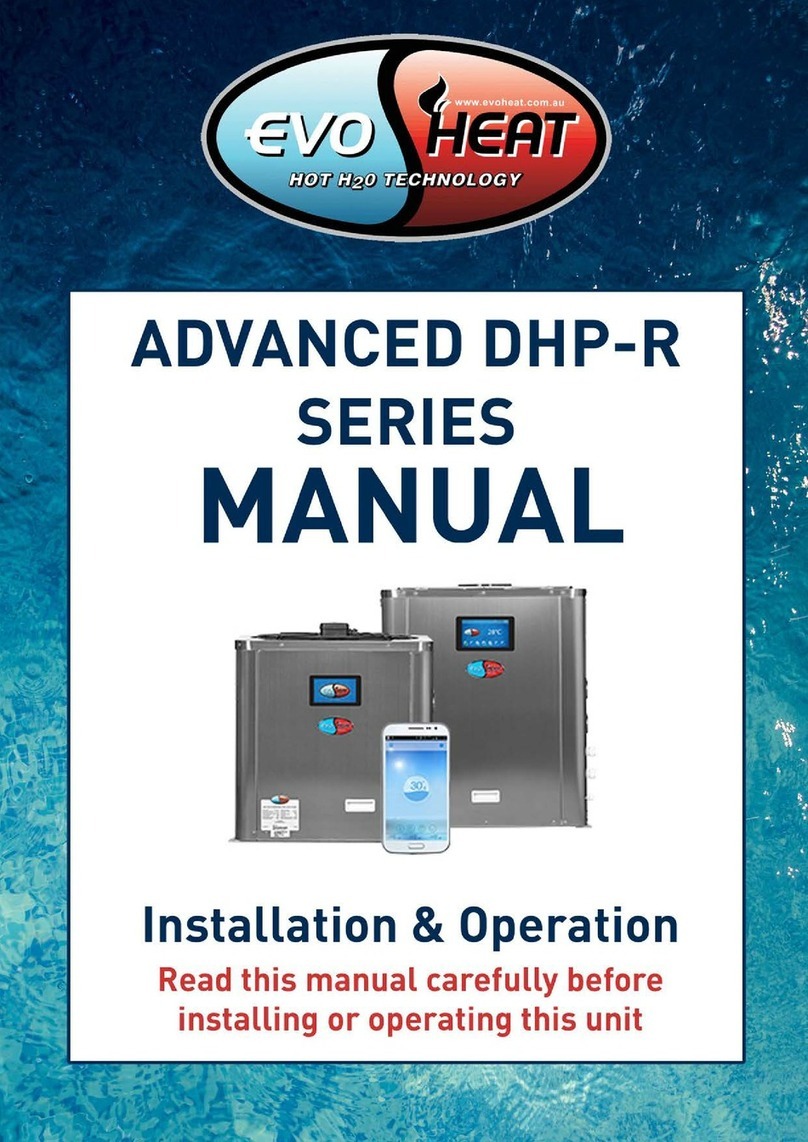
evoheat
evoheat DHP-R Series Installation & operation manual

Stelpro
Stelpro RUH2 user guide
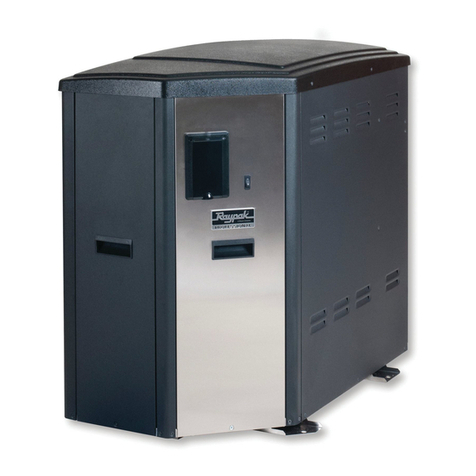
Raypak
Raypak X94 Installation & operating instructions
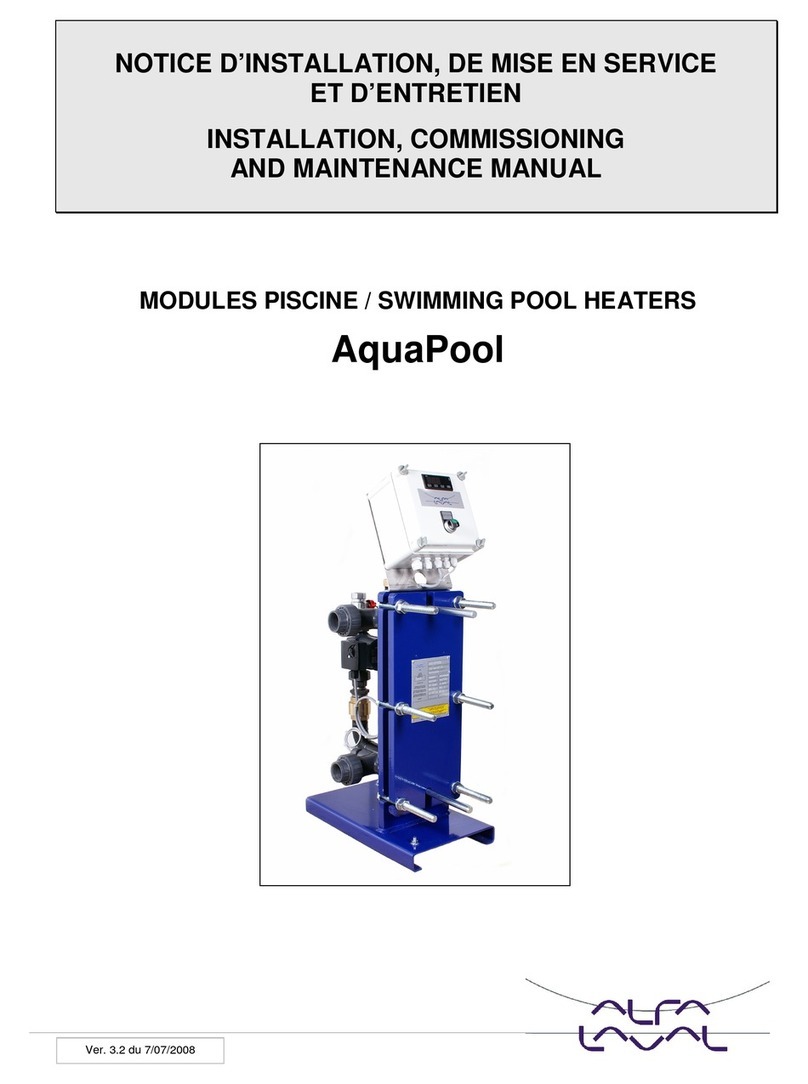
Alfalaval
Alfalaval AquaPool-7 Installation, commissioning and maintenance manual

KStar
KStar K-5-D instruction manual
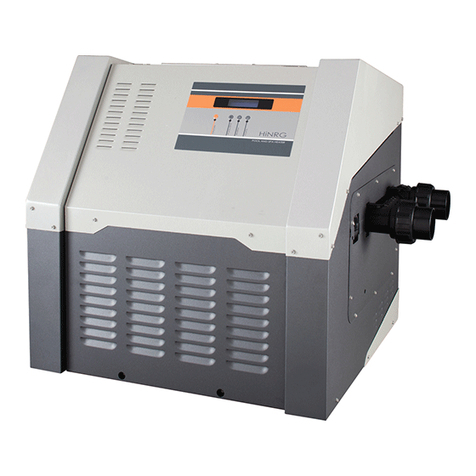
Astral Pool
Astral Pool 175 Installation and operating instructions
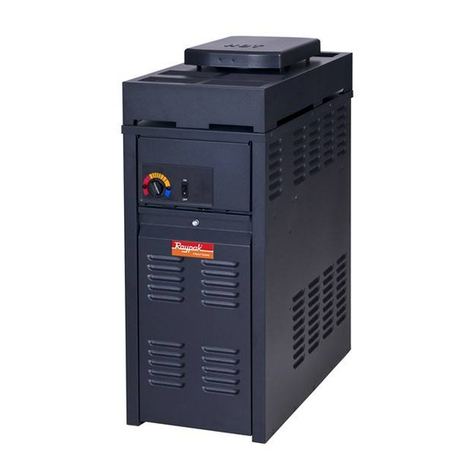
Raypak
Raypak 130A Installation & operating instructions

ThermoTec
ThermoTec Pro Heat Pump Pool Heater Installation & operating instructions
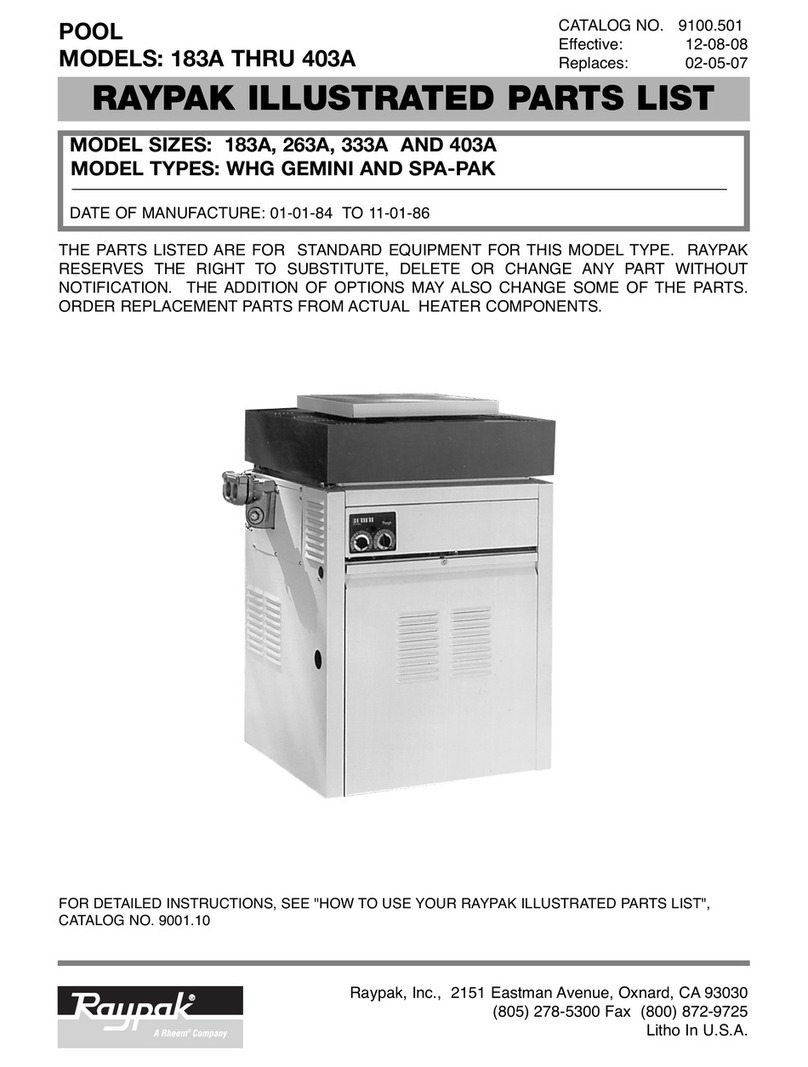
Raypak
Raypak 183A Illustrate parts list
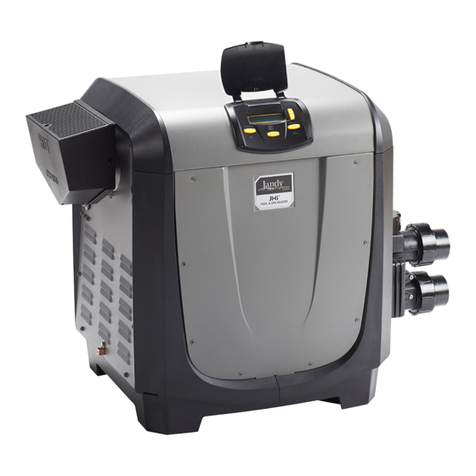
Jandy
Jandy 200 Installation and operation manual

MED Associates
MED Associates ENV-597 user manual
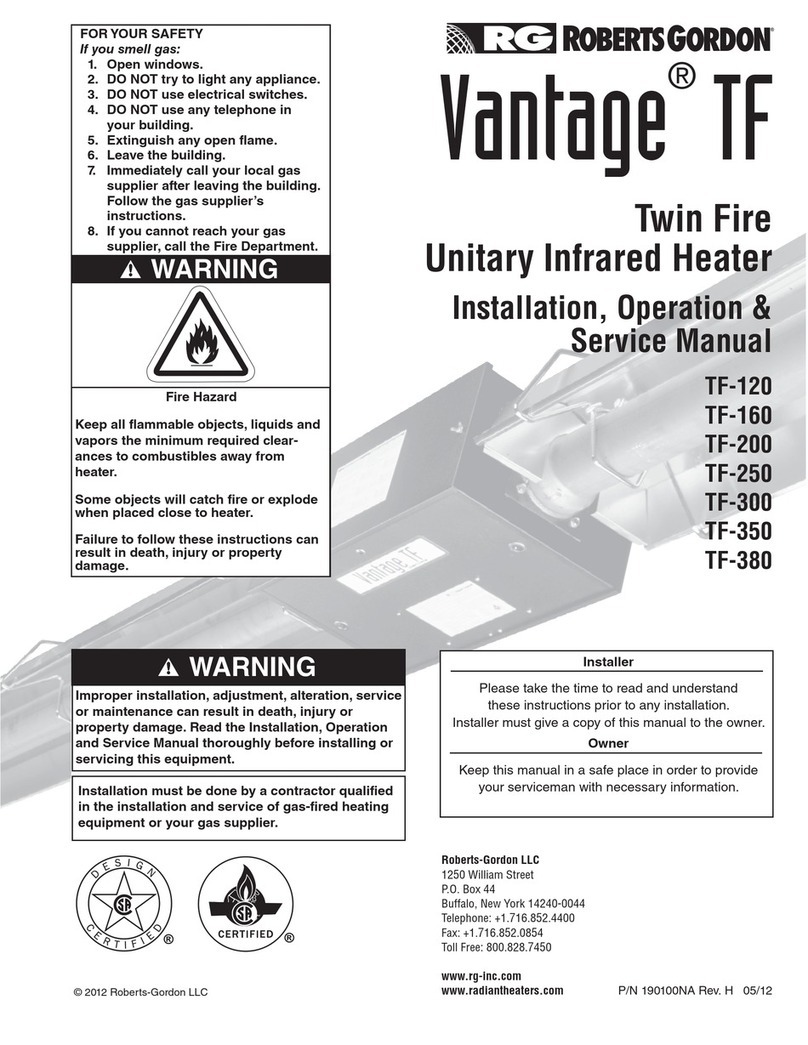
Roberts Gorden
Roberts Gorden Vantage TF-120 Service manual


